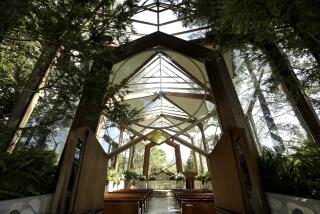$1 Million Boosts San Juan Mission
- Share via
The Great Stone Church at Mission San Juan Capistrano, which received a $1-million state grant Monday, is on its way to restoration once again.
Although $5.4 million more is needed to complete the refurbishment of the church and vestry, the check from the state is significant.
It marks the first time government funds have gone toward preserving the church and allows the preservation project to gear up again after being stalled since January for lack of funds. The $1 million will be used to make the five-story-high dome, now cracked and held together by scaffolding, structurally sound.
Mission officials hope the public grant will be the start of a public-private partnership that will speed up fund-raising for the $7-million preservation effort. Already, $600,000 in private donations has been pledged.
The restoration has been a long time coming.
Completed in 1806, the church enjoyed a heyday that was all too brief. Just six years after opening, an earthquake knocked loose the 120-foot bell tower, which collapsed into the sanctuary, killing 40 worshipers.
Built by the Juaneno Indians for the Spanish missionaries, the church was the largest stone building west of the Mississippi at the time. Experts laud its architectural significance and the achievement of constructing it in the early 19th century in California.
“It’s amazing that they could build a Greco-Roman temple in the wilderness 200 years ago,” mission administrator Jerry Miller said.
Although there have never been plans to make the church whole, “a magnificent ruin says something too,” Miller said. “Somehow this ruin says these people persevered, they survived, they overcame these disasters.”
The $1-million check, a mock-up of which was presented at the mission by two state lawmakers Monday, is needed for the second phase of the restoration project, which will preclude the need for so much scaffolding to hold the dome together.
Much of the scaffolding--which has obscured the dome’s Greco-Roman beauty for a decade--may come down as early as March, in time for a visit from the town’s fabled swallows.
Some swallows have nested elsewhere since the scaffolding went up to keep the crumbling walls from falling on the 550,000 annual visitors to the mission.
“We’ve got to be ready for the swallows to come home to a safe haven,” Miller said.
People will gain safe admittance too: They will once again be allowed to wander through ruins that have been called America’s Acropolis and gaze up five stories at the artwork on the sanctuary dome.
State Sen. Bill Morrow (R-Oceanside) and Assemblywoman Patricia Bates (R-Laguna Niguel) asked for $7 million in state funds for the church, but the request was pared back to $2 million by the Legislature, then cut in half by Gov. Gray Davis.
Bates said she was awe-struck by the tour of the church and mission following the check presentation ceremony Monday morning.
“I was really humbled by the fact that 200 years ago, the Indians and Father Serra toiled there to build a community,” Bates said. “California’s heritage is encapsuled there.”
Or as Miller says it, in three years, when the restoration is complete, “It will be an awesome remnant of a very romantic past.”
(BEGIN TEXT OF INFOBOX / INFOGRAPHIC)
State Money for Mission Church
A $1-million grant from the state was presented to Mission San Juan Capistrano on Monday to help preserve the Great Stone Church. The structure was completed in 1806, only to fall six years later in an earthquake. The restoration of the church is $7-million project, with an additional $5.4-million needed to complete the preservation of the church, according to mission officials. About $600,000 in private donations already have been pledged.
Bells: The four bells in the Sacred Garden once hung in the bell tower of the Great Stone Church.
How part of the money will be used:
Walls: Replace disintegrated mortar in stone walls; replace fallen stones.
Pillars: Recarve from stone the rotting base of pillars, which support the weight of walls.
Dome: Stabilize the five-story tall sanctuary dome, which has a four-inch crack and is partially collapsed. Visitors can then veiw the restored paintings on the ceiling.
Source: Mission administrator Jerry Miller
More to Read
Sign up for Essential California
The most important California stories and recommendations in your inbox every morning.
You may occasionally receive promotional content from the Los Angeles Times.










